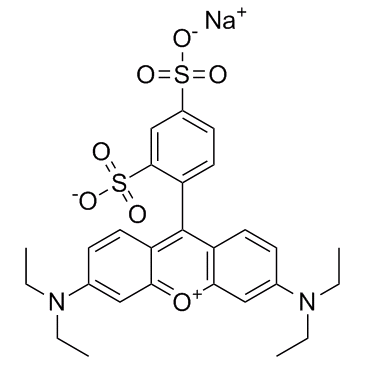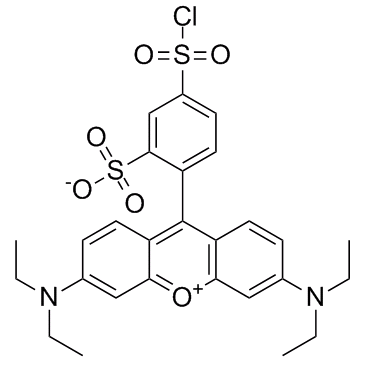3520-42-1
| Name | lissamine rhodamine |
|---|---|
| Synonyms |
4'-Butoxy-3-piperidinopropiophenone hydrochloride
Tanaclone EINECS 222-529-8 dyclonine hydrochloride SULFORHODAMINE B MFCD00010180 C.I. 45100 Xanthylium, 3,6-bis(diethylamino)-9-(2,4-disulfophenyl)-, inner salt, sodium salt (1:1) dye acid red 52 Sodium 4-[6-(diethylamino)-3-(diethyliminio)-3H-xanthen-9-yl]benzene-1,3-disulfonate Sulforhodamine-B Dyclone N,N,N',N'-tetraethylsulforhodamine rhodamine 200 S sodium salt Dyclocaine hydrochloride Dyclonine HCL Acid Red 52,Sulforhodamine B monosodium salt Dyclothane Acid Red 52 C.I.Acid Red 52 Sulforhodamine B sodium salt Sulforhodamine B (sodium salt) |
| Description | Sulforhodamine B sodium salt is a fluorescent dye with uses spanning from laser-induced fluorescence (LIF) to the quantification of cellular proteins of cultured cells. |
|---|---|
| Related Catalog | |
| In Vitro | Sulforhodamine B (SRB) is often used as a membrane-impermeable polar tracer or used for cell density determination via determination of cellular proteins (cytotoxicity assay). The SRB assay has been used to inexpensively conduct various screening assays to investigate cytotoxicity in cell based studies. This method relies on the property of SRB, which binds stoichiometrically to proteins under mild acidic conditions and then can be extracted using basic conditions; thus, the amount of bound dye can be used as a proxy for cell mass, which can then be extrapolated to measure cell proliferation. The protocol can be divided into four main steps: preparation of treatment, incubation of cells with treatment of choice, cell fixation and SRB staining, and absorbance measurement. This assay is limited to manual or semiautomatic screening, and can be used in an efficient and sensitive manner to test chemotherapeutic drugs or small molecules in adherent cells. It also has applications in evaluating the effects of gene expression modulation (knockdown, gene expression upregulation), as well as to study the effects of miRNA replacement on cell proliferation[1]. |
| Cell Assay | Gently add 25 μL (96-well format) or 5 μL (384-well format) cold 50% (wt/vol) TCA to each well directly to medium supernatant, and incubate the plates at 4 °C for 1 h. Mixing is not required, as this could lead to some cells detaching from the bottom of the well. Wash the plates four times by submerging the plate in a tub with slow-running tap water and remove excess water by gently tapping the plate into a paper towel. After the last wash allow the plate to air-dry at room temperature. Add 50 μL (96-well format) or 20 μL (384-well format) of 0.04% (wt/vol) SRB solution to each well. Leave at room temperature for 1 h and then quickly rinse the plates four times with 1% (vol/vol) acetic acid (200 μL for 96-well format or 30 μL for 384-well format) to remove unbound dye. Allow the plate to air-dry at room temperature[1]. |
| References |
| Molecular Formula | C27H29N2NaO7S2 |
|---|---|
| Molecular Weight | 580.65 |
| PSA | 150.78000 |
| LogP | 7.81310 |
| Water Solubility | methanol: 1 mg/mL |
CHEMICAL IDENTIFICATION
HEALTH HAZARD DATAACUTE TOXICITY DATA
MUTATION DATA
|
| Symbol |

GHS07 |
|---|---|
| Signal Word | Warning |
| Hazard Statements | H315-H319-H335 |
| Precautionary Statements | P261-P305 + P351 + P338 |
| Personal Protective Equipment | Eyeshields;Gloves;type N95 (US);type P1 (EN143) respirator filter |
| Hazard Codes | Xi |
| Risk Phrases | 36/37/38 |
| Safety Phrases | 22-24/25 |
| RIDADR | NONH for all modes of transport |
| WGK Germany | 2 |
| RTECS | BP6750000 |
| HS Code | 3204120000 |
| Precursor 0 | |
|---|---|
| DownStream 1 | |
| HS Code | 2921499090 |
|---|---|
| Summary | 2921499090 other aromatic monoamines and their derivatives; salts thereof VAT:17.0% Tax rebate rate:9.0% Supervision conditions:none MFN tariff:6.5% General tariff:30.0% |



